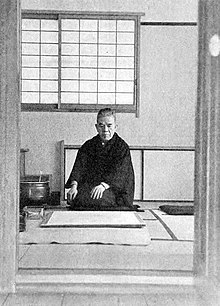
Togyū Okumura (奥村 土牛, Okumura Togyū, 18 February 1889 – 25 September 1990) was a famous Japanese modern painter of the Nihonga style of watercolour painting. His original name was Yoshizō (義三). The name Togyū referred to a poem from his father who ran a publishing business.
Okumura is characterized by his works which achieve unusual, exquisite quality of colours through the application of the white gofun pigment 100 or 200 times as foundation.
Biography
- 1889 Born in Kyōbashi, Tokyo.
- 1900 Completes shogakko (junior school).
- 1926 Makes the acquaintance of Hayami Gyoshu.
- 1959 Becomes a director of the Japanese fine arts institute.
- 1962 Awarded the Japanese Order of Culture.
- 1978 Appointed chief director of the Japanese fine arts institute.
- 1990 Dies aged 101.
Major works
He painted Mount Fuji, which is in the Tokyo Imperial Palace.
- 鳴門 (1959, 128.5×160.5 cm)
- 鹿 (1968, 114.7×145.0 cm)
- 醍醐 (1972, 135.5×115.8 cm)
- 閑日 (1974, 73.0×100.0 cm)
- 吉野 (1977, 108.6×184.4 cm)
- 富士宮の富士 (1982, 76.1×115.1 cm)
- 蠣 (1984, 102.0×131.0 cm)
- 寅 (1985, 16.2×49.5 cm)
Books and collections of work
- スケッチそのをりをり (collection of sketches, 1917)
- 牛のあゆみ (autobiography, 1974)
Major collections holding works by Okumura
- Okumura Togyu Memorial Museum (Nagano prefecture)
- Yamatane Museum
See also
References
- Japanese arts, what & where? Tatsuo Takayama - 1987
This article about a Japanese painter is a stub. You can help Misplaced Pages by expanding it. |